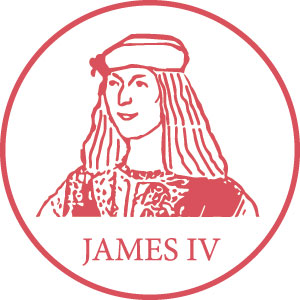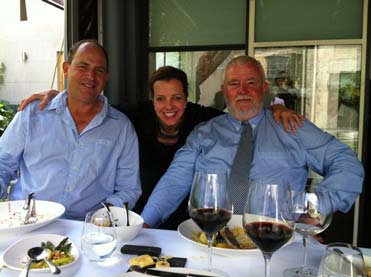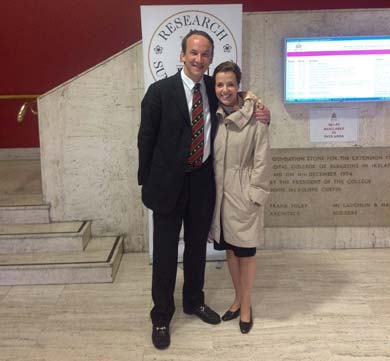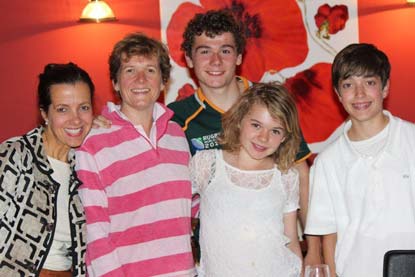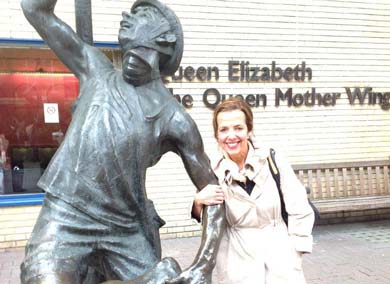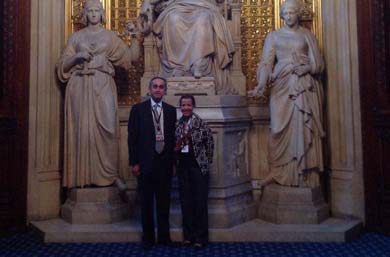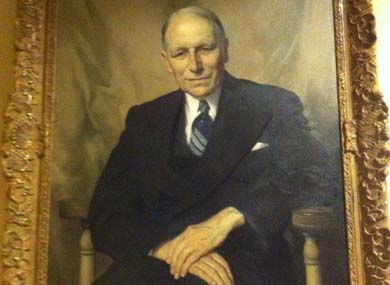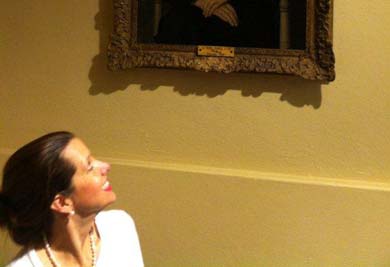James IV Traveling Fellowship
Diaries of a Traveling Surgeon
Nancy D. Perrier, MD
We travel as an expression of passion for the world.
We travel to ardently pursue all we hope to discover.
We travel to be surprised, so that we don't stop questioning.
We travel to exchange ideas, beliefs and values.
We travel to cultivate compassion, to stretch our hearts and expand our souls.
We travel to see someone smile, and smile back at them.Unknown
This year I had the remarkable opportunity to see more of the world, learn and share surgical knowledge. I give great thanks to the James IV Association of Surgeons for making this possible. I am forever honored and grateful for this opportunity. I also thank my family for their support. I travelled in two blocks, the first in Europe in May-June 2013 and the second in Australia, Tasmania and New Zealand in Dec 2012. My goals were to understand and observe surgical technology and teaching and to observe clinical surgical endocrine practices. I am grateful for the warm hospitality extended by IRCAD, Lord Ara Darzi, Dr. Greg Sadler, Prof. James O. Garden, Rowan Parks, Bruce and Dr. Julie Miller and Dr. Richard Harmon and Professor John Windsor.
Week of June 5-9, 2012
Tuesday started with a meeting at IRCAD, the premier surgical training center in France. The meeting was primarily with Luc Soler, a technical genius at the integration of imaging and surgery. IRCAD functions as a core center that allows researchers, engineers, computer scientists, robotic engineers, international surgical experts, and industry leaders to meet and collaborate. Chang Ng, a radiologist colleague from The University of Texas MD Anderson Cancer Center, joined us. We discussed hybrid operating rooms and intraoperative medical imaging, which allows for real-time tracking during surgical procedures. Computer-assisted surgical planning is now available using virtual patient software, and visual biological targeting is possible. We discussed validation of 3-dimensional (3D) modeling of organs and glands, specifically the adrenal gland. IRCAD currently has an online patient modeling service that allows for volume rendering. This form of reality imaging can complement and guide complex surgical procedures. Luc believes that of the 700 surgical errors that occur worldwide each day, many could be prevented with augmented reality computer software.
On Thursday, Luc, Chang, and I discussed the logistics of incorporating IRCAD's virtual surgery software into clinical practice. To obtain virtual surgery rendering, the surgeon uploads de-identified patient images, the patient is given an institution identification number, and the 3D modeling application is utilized. Ideal images to be used for rendering are 1.6 mm of thickness or less. The patient should be scanned in the position of the surgical procedure. For adrenal glands, this would be the lateral decubitus or prone jackknife position. Oral contrast is not needed, but intravenous contrast is. The IRCAD software is unique; image quality is maintained even when the direction and rotation of the images change. It is our hope that we can collaborate with IRCAD for validation of this imaging surgery modeling. To that end, we will invite Luc to MD Anderson in the spring of 2013. We plan on obtaining images through that time and then will collaborate with him at the International Association of Endocrine Surgeons meeting in August 2013. In addition, we hope that we can collaborate through the MITIE center for training.
Together, Luc, Chang, and I devised a prospective, randomized, controlled trial comparing posterior retroperitoneoscopic adrenalectomy to adrenalectomy performed with augmented reality assistance. The aim of the study is to answer whether augmented reality/virtual surgical assistance, including patient-specific surgical simulation and intraoperative 3D modeling of the adrenal glands and surrounding structures, improves surgical outcomes. Inclusion criteria include consecutive adult patients scheduled for posterior retroperitoneoscopic adrenalectomy to be performed by surgical endocrine faculty. Excluded would be children, patients unable to consent, patients unable to undergo contrast-enhanced CT, and patients with a glomerular filtration rate less than 45. The primary endpoints of the study will be operative mortality, complications, operating room time, length of operative dissection, and operating room blood loss. In addition, postoperative pain requirement and length of stay will be assessed. We will require technologic lessons from the IRCAD on production and modeling of images. In return, we hope that we will be able to provide IRCAD with validation of the software that they have devised.
On Friday, I attended the Urologic Surgical Course sponsored by IRCAD; this included videos of transabdominal adrenalectomy procedures. One video demonstrated the use of fibrin glue and gel for remnant bleeding following subtotal adrenalectomy. In addition, hybrid surgery through a transvaginal entry was shown. Additionally, single port surgery that used multiple fistula entry points for good internal retraction was shown. Alternative access sites were noted. During the surgery, "spider" equipment was used; this equipment prevents crossing of instruments without sacrificing the ability to triangulate in the abdominal cavity. The system was bendable, which avoided crossing of the hands. During the course, Luc gave a lecture on new technology and concepts. The main message of his talk was that with new surgical technology, quality can be achieved that is greater than the sum of its parts--the lone surgeon can use automated guidance, and computer assisted surgical planning can improve individual procedures. The latter begins with medical imaging of the patient so that a plan can be developed and simulation can be performed before the actual procedure. 3D patient mapping allows the surgeon to visualize organs, blood supply, and possible areas of complex dissection and perfect tool and instrument placement. We toured Strasbourg. We then took the high-speed train to Paris and flew to London. My 13-year-old son Daniel was my travel companion for the rest of my trip.
Week of June 17-23, 2012
Upon my arrival at St. Mary's Queen Elizabeth, the queen mother Hospital on Monday. Chris Nicola gave me a warm introduction to the Hamlin Surgical Technology Center led by Lord Ara Darzi. The team had graciously put together a series of presentations by the research fellows to highlight the work being done on quality, safety and surgery.
On Tuesday, I observed James Smellie performing thyroid and parathyroid operations at the Chelsea Westminster Hospital.
On Wednesday morning, I attended the Royal Marsden Endocrine Tumor Board. That afternoon I met with David Scott-Coombes to discuss the British Endocrine Surgery registry. The meeting took place at the Royal College of Surgeons. What an incredible place! David and I met on the 4th floor of the Hungarian Museum and reviewed the BAETS website and registry. The registry lists the cases performed by British endocrine surgeons. Members input their own patient data. The system provides instant feedback and risk plots based on a comparison of the surgeon to peers. An audit subcommittee, created by the BAETS and Dendrite (the licensing company), analyzes the data periodically and reports to the members.. The quality of the data depends on accurate reporting by members. The registry is recognized by the British College of Surgeons. This feature is the carrot for "buy in" from surgeons. To date, more than 37,000 cases have been registered. The data allow one to make predictions about future outcomes based on past outcomes. I gleaned that the key to a registry's success is to conduct a pilot to make sure it is user friendly and then to utilize the information to answer scientific and quality assessment questions. I could have easily spent the entire day walking around the Royal College and enjoying the robust surgical history. While there I admired the genius of John Hunter, the founder of scientific surgery, who was a consistent and expert user of the experimental method. David and I discussed collaborations and combining the American Association of Endocrine Surgeons meeting and the British Association of Endocrine and Thyroid Surgery in 2016.
On Thursday afternoon, I met with Professor Yang (Department of Biosurgery and Surgical Technology) at Imperial College. We discussed global health and I recognized that the work of the Hamlin Center is based on prevention, intervention, and imaging. Professor Yang shared a prototype of an earpiece that was able to measure balance, biorhythm as a surrogate for post operative recovery. This ingenious device will alter medical monitoring in the future. It was obvious through our discussions that Professor Yang and Lord Darzi (of Denham) have a true collaboration that is based on friendship and natural cooperation of like personalities. That evening we met with Lord Darzi at Parliament's House of Lords. We observed a Lordly debate and then met his wife Wendy for cocktails. From our conversations, I recognized that Lord Darzi's unparalleled success at advancing regionalization of care started with a series of timely manuscripts after which he was invited to help review the national health services system. Lord Darzi attributes his success to collaboration. He believes that if colleagues respect you, they will listen to you.
On Friday, I gave Grand Rounds on Technical Advancement of Adrenal Surgery at the Chelsea Westminster Hospital. I then went to the Royal Marsden Hospital to observe Ara operate. He performed a difficult laparoscopic lower anterior resection of the rectum on a patient who had undergone neoadjuvant chemotherapy. Lord Darzi is clearly a technical master. The use of heat scissors in his right hand with Ray-tech gauze in his left hand as the dissector was key. I also appreciated that the team used the help of gravity with manipulation of the bed to help with natural retraction. That evening we drove to the home of Lord Darzi and Wendy for dinner. At dinner, we discussed the National Health Service, which eliminates waste by setting into place end of life and dignity and dying protocols. We exchanged ideas about medical reform within the United Kingdom and United States, including paying providers based on quality and standardization of fees. The U.S. system is currently good at providing personalized care, and the United Kingdom is good at eliminating the occasional provider whose outcomes are not satisfactory. Centers of Excellence depend on 1) high volume and 2) monitored outcomes. We discussed our desire to write a combined letter to the New England Journal of Medicine in an effort to expose unethical business practices secondary to aggressive marketing techniques in the medical industry. We agreed that reporting series without critical appraisal makes it difficult for consumers to shop wisely.
On Saturday, I met with Fastow Palazzo to discuss the new protocols for the BAETS that call for pre- and postoperative laryngoscopy of the vocal cords We discussed choosing professional partners and agreed that a true leader builds a department of people who are each individually interesting. The best means of recruiting a partner is to choose a person rather than a CV. We also discussed the rich tradition and history of Selwyn Taylor from the Hammersmith Hospital. I discovered that Fastow spent time in Australia, and we discussed the multiple endocrine neoplasia syndrome population in Tasmania, a place I hope to visit on the second leg of the James IV Traveling Fellowship. That evening we had dinner with the James Smellie family. During dinner, we discussed Willy Walker, a Houston surgeon and James Smellie's godfather.
Week of June 24-30, 2012
On Monday, I met Penny Earle, the James IV administrator; her help made our trip seamless.
On Tuesday, I met with Ken Fearon at the Western General Hospital. We talked about enhanced early recovery. Ken's anesthesia and surgery teams have provided continuity of care that has resulted in the lowest mortality rate in the country for colorectal surgery. Ken was operating on a young woman with colitis who needed a proctectomy. The proctectomy was part of her personal "to do's" before her wedding in 3 weeks. She appeared happy and content with her decision and its timing. As I rounded with Ken that day on the wards, I recognized that several of his patients were nonsurgical based on risk factors. One example was a 70-year-old woman with obstructing colon cancer. She was stented and was perfectly content with being discharged with no plans for surgical resection. The patient population seemed content with the realization of limited care. The rooms on the wards were large, were segregated by gender, had shared baths, and had limited privacy. That morning Ken and I had a long discussion about nutrition and preoperative carbohydrate loading to prevent insulin resistance in the colon and rectal patient. The philosophy is that if you treat patients as if they are going to do well and go home they will; you shouldn't treat them as if they are going to have a complication. We discussed patient satisfaction as an effective marker for outcome. Watching Ken operate with his Long Star anal retractor was ironic for this Texan.
On Wednesday, my son and I visited the Freon School, the alma mater of David Cameron, U.K. Prime Minister. That afternoon, we went to Dynamic Earth and visited Edinburgh Castle. History, including medical and surgical history, comes to life in this great region. At the Edinburgh Royal College of Surgeons, I got to see the original James IV portrait and also exhibits on Lister, Alexander Graham Bell, and Simpson, the obstetrician credited with general anesthesia. Taking note of the man in whose honor the Traveling Fellowship is bestowed was a "stand still" moment. The original oil painting is quite impressive. I also had a chance to meet with Rowan Parks. He is a surgeon and researcher and teaches at the Royal College of Surgeons, the Royal Infirmary and the University of Edinburgh. He exemplifies the ideal close relationship of education, clinical practice, and research.
On Thursday, I met Lorna Marson, Program Director for Surgical Training . We had a great conversation about women helping women and building each other up rather than tearing each other down. We talked about having life balance, loving what we do, helping avoiding ego, and role modeling for kids.
Then I spent the afternoon with the fellows at the Royal Edinburgh Infirmary. Damian James and I talked about the combination of science and clinical training. On the way home from the hospital that evening, I shared a taxi with an interesting gentleman who had just given a lecture at the Royal Infirmary on cognitive behavioral therapy.
That evening we had dinner with Archie and Iona Cable and Lorna Marson. We talked about the school at Tyne that is the prototype for Hogwarts in J.K. Rowling's Harry Potter books. We met Lorna's husband, John Forsythe, who is a transplant and endocrine surgeon, and talked about his role in the European Transplant Society meeting at which iPads were used by the participants and organizers. Their meeting has grown but uses small group clinical discussions of previously submitted abstracts to prevent losing the small group feel.
On Friday, I met with O. James Garden and Rob Padbury for dinner. We discussed meeting management and administrative changes. James's approach is to use a company that provides personalized service before the company gets too commercialized. That afternoon I met with Rachel Harris, a surgical trainee looking for advice and mentoring on endocrine surgery. I also met with a hepatobiliary transplant surgeon conducting pancreas cancer work pertaining to tumor spread. In addition, I met with Murat Akyol, a transplant endocrine (adrenal) surgeon. We discussed total parathyroidectomy, the European laws on cryopreservation of resected parathyroids, and the population numbers for Scotland and the National Health Service. We also discussed pre- and postoperative diagnostic imaging and the use of molecular markers in thyroid tumors. In the case presentations, I recognized that their use of PET and MRI is more abundant than our use in the United States. I was able to see a 4D CT scan prepared by their radiologist that was of excellent quality.
Off to the Emerald Island
On Saturday, we had dinner with old friends Diarmuid and Deirdre ORiordain at a lovely steak house in Dublin. Twenty years ago we trained together, shared laughs and a mentor, and then went our separate ways. Reuniting and reconnecting was an amazing experience. Diarmuid has reinvented himself from an endocrine and colorectal surgeon to a minimally invasive surgeon. He was a technical master even during our shared training, and he is certainly still one now.
Old friends Billie O'Connor and Gillian Gibson took us into their home in Cork. David Goff came over for a drink. We had a lengthy discussion about The Emperor of All Maladies: A Biography of Cancer by Siddhartha Mukherjee. I purchased it online and it was my read for the remainder of the trip.
In Dublin, Paul Tibletts kindly picked me up at the Pembroke Townhouse on Monday morning. I met with the surgical research team at the Royal College of Surgery. Three of Arnie Hill's fellows presented their work. We discussed posterior retroperitoneoscopic adrenalectomy, secondary hyperparathyroidism, and the use of cinacalcet. We discussed Arnie's work on cost-effectiveness analyses of Cinacalcet as a bridge to surgical intervention. We also discussed his approach to parathyroidectomy. He does not have the capability of intraoperative parathyroid monitoring, and his imaging studies have a localization rate of approximately 50%.
On Tuesday, I toured St. Vincent's Hospital. Des Winter was a wonderful host. I gave a talk on The Evolution of Adrenalectomy and met Ronan O'Connell, Secretary of the James IV Association, who introduced my talk and me. We discussed the role of new technology in surgical procedures. James Geraghty led a dynamic afternoon of intellectual exchange.
That evening Arnie Hill and Enda and James Daughty arranged for a lovely meeting with three fellows, all women.
The following morning, Arnie's fellow picked us up at the Pembroke and whisked us away to the Beaumont Hospital. Waiting for us there was a patient with primary hyperparathyroidism and negative imaging studies. The opportunity to scrub in and explore the neck was irresistible. Less than an hour later, Arnie and I found the gland in the right tracheoesophageal groove--a classic right Type C gland.
That afternoon, we toured Trinity College, including its science centers. I also could not resist visiting the Medical College of Dublin to see the statue and stand in the conference room named after Sir James Graves, for whom the disease I commonly treat is named.
We then traveled to Oxford with warm reception from Greg Sadler- a common day version of a true Renaissance man. I could not have imagined his incredible generosity and personal commitment to make the James IV trip one of a lifetime. He opened his home, family, office, and OR to me. I will never be able to repay him for his time, attention to detail and stimulating conversations.
One afternoon I met with Mr. Peter Walton, president of Dendrite, a data registry company. We discussed the power of data registries to change behavior and help implement new policy. Freddie Hamby, head of the department of Urology at the John Radcliffe Hospital, generously received me. I spoke gave a presentation on New Technology to their multidisciplinary surgical group. The Radcliff Hospital is big and beautiful. A lunch meeting with Peter McCulloch of the Nuffield Department of Surgery was delightful. We discussed his ALIGN projects for the safe dissemination of new procedures. His thoughts are similar to our current philosophy. I hope to establish future collaborations with him. Dinner at Exeter College, hosted by Peter, was most memorable. The traditions were palpable. Simone James, CEO of an Oxford private hospital with 6 beds, shed light on U.K. healthcare.
Professor Neil Mortenson, current James IV President and I met and discussed leadership styles. When he asked if I was alpha or beta, I required a moment of contemplation to decide.
I also had an opportunity to meet Paul Johnson, prior James IV Traveler, who was in Japan during the 2011 earthquake and tsunami and John Wass, the endocrinologist who won the 2012 Endocrine Society award. Daniel and I attended Grand Rounds at Oxford, where a U.K. hepatobiliary surgeon spoke on surgery in the Afghanistan war.
Australia and New Zealand (December 9-21, 2012)
Melbourne (Wonderful Hosts: Dr Julie Miller and Professor Bruce Miller)
I was graciously hosted by Professor Miller and stayed in their lovely home. I had met Bruce when he traveled as a James IV and came to Houston. Julie, his wife, is a Houston native and is American trained. I have come to know her as a good friend through Endocrine Surgery. She visited me in Houston during her own sabbatical in 2010.
I arrived and headed directly to the private hospital where Julie practices. She was waiting for standard cervical exploration, thyroidectomy and central neck dissection and left posterior retroperitoneal adrenalectomy. Julie and I discussed the role of concomitant ipsilateral central neck dissection with thyroid lobectomy for well-differentiated thyroid carcinoma. We had friendly dialogue about the extent of resection. We rounded and then attended multidisciplinary endocrine rounds attended by medical endocrinologists, radiologists and pathologists. I quickly learned that the Royal Melbourne is the major teaching hospital for the University of Melbourne School of Medicine and is a major site for training surgical residents and registrars. The trainees train for 2-3 years in basic medicine and then do 4 years of advanced training in surgery. Most then travel overseas for subspecialty training. Cases were reviewed and discussed with the group. I gave a lecture on asymptomatic PHPT. The discussion was lively. We then attended a clinical multidisciplinary conference at the Royal Melbourne covering treatment plans for thyroid cancer. The face sheets used for consistent documentation and clinical care pathways were excellent and very detailed with decision-making clarity. I have brought that idea back to MD Anderson for implementation. That evening Julie and I visited The Australian Royal College of Surgeons. We were befriended by a historical librarian and learned many details about Sir Thomas Peel Dunhill. He is a surgical icon in the thyroid surgery and we were able to view his original portrait, which hung in the boardroom of the College. We met with the author of the book about Sir Thomas Dunhill, Ivo Vellar. A retired surgeon with many years under his belt this was truly a highlight for me. He had operated in London and back in the same operating room at St. Vincent's hospital. We met with him there and shared a wonderful afternoon learning all there was to know about the man who operated on three generations of royalty. I met with the hospital administrators at the Royal Melbourne and discussed clinical safety and effectiveness. The hospital president and research data coordinator for the entire system was stimulation. We discussed who pays for data entry, cross-pollination between networks, massed practice, proficiency goals and how high they should be. That evening we had a dinner at the Royal Melbourne private dining hall in honor of Michael Luxton, a marvelous internist who died prematurely of metastatic melanoma. I gave the named address on the following day titled the "A 100 year Odyssey of Adrenal Surgery" The auditorium was filled, including Michael Luxton's widow. His former colleagues including cardiologists, pathologists, anesthesiologists were in attendance. I spent time in clinic and with the residents. Bruce and Julie were incredibly hospitable and truly showed me all the best of Melbourne- the market, the shopping, the park and even dinner on the river. Jonathan Serpel his wife joined us for drinks and we discussed the status of the IAES. On Sunday a multidisciplinary team came over for summer paella. Great fun. Julie and Bruce were showed me hospitality that will never be able to be repaid. The front bedroom of their home became my own, with my own Barista, their adorable son Douglas. Their children made me feel right at home and the yard, flora and fauna were nothing short of amazing. My family definitely needs to visit.
I travelled to Hobart, Tasmania. Julie Miller accompanied me. Peter Stanton, the renowned Endocrine surgeon, picked us up at the airport and served as our local host. We spent time with the MEN I group, well known for the constellation of genetic carriers and cluster of pedigrees with this disease on the island. I spent time with John Burgess in the MEN1 clinic at the University. We discussed effective MEN 1management, life-long screening strategies and prevention of secondary complications. His expertise on how this should take place in a structured fashion was of great value. I was able to observe how the team treats modifiable risk factors for MEN 1-related complications, manages specific complications and provide counseling, genetic testing and follow-up for family members. I spent the afternoon in clinic and was fascinated by the genotype/phenotype presentations amongst the kindreds. They are interested in initial parathyroid presentation and the role of total vs. subtotal parathyroidectomy. That evening we toured Hobart and were treated to dinner by Peter.
After crossing "the ditch of the Tasmanian Sea", I was met at the Auckland airport by Richard Harmon. I am forever thankful to him for helping to arrange the trip. I had a short period of time to tour this beautiful city. I stayed at the Waite Mata Harbor. Richard and his wife Helen had a beautiful dinner at their home and I met their three boys. We laughed and caught up on old times of life in training in Rochester Minnesota. Richard and I had been peers there and shared wonderful memories of chart checks and manuscript writing. I had lunch with Professor John Windsor. We discussed thyroid surgery and the status of surgical simulation training and outcomes. We discussed health care in New Zealand. The system is government run and health care authorities in the region. We had an interesting discussion about measuring quality and outcomes and regionalization of care. He has committed a lot of energy to a multimedia curriculum including 3D anatomy for procedural training, That night I had a lovely dinner with the trainees, academic and private faculty. This was a bright, engaged and committed group and the discussion was lively. I met Magdalena Beggar and we discussed the combination of general and breast and endocrine surgery. She was a great dinner mate and I was terribly interested in the motivated speaker life of her husband. Following this, I met with Simon Grodski. He was a wonderful host and friend. Richard and John and Simon organized an Endocrine Surgery Multidisciplinary course. It was attended by attending surgeons from the private sector and academia; registrars, fellows and junior trainees; and other disciplines such as pathology, internal medicine, radiology and anesthesia. I gave an address titled," Posterior Retroperitoneoscopic Adrenalectomy" I presented the results of our series comparing anterior to posterior and the role of implementing robotic equipment. We discussed cortical sparing adrenalectomy. The session was interactive and there were good discussions about surgical techniques, It was clear that they have a well functioning, productive and collegial group with a high quality research culture. These Kiwi friends were the epitome of gracious hosts.
Summary
The James IV Traveling Fellowship reminded me of the importance of collaborations and relationships with surgeons and scientists elsewhere. Good care, good outcomes, and other great things are about relationships. Of course, people cannot be forced to collaborate; effective collaborators genuinely like each other, are of like minds, and choose to come together.
Success breeds success, and sometime it is about being at the right place at the right time. For the Lord Darzi, success resulted from good quality work that led to political backing and a policy-making opportunity.
The James IV travels made me aware that practices in the United Kingdom, France, Australia, New Zealand and the United States are more similar than different. Hard work invested in providing good clinical care can be superimposed from one clinic to the other-- on both this and that side of two ponds.
Most appreciated was the precious gift of time. How special to have had this time, and to have others (partners, boss, friends, strangers, hosts, assistants, patients, colleagues, peers) give so much to me. It's been a great journey. One that will always be treasured, every detail remember. . This remarkable opportunity can never possibly be repaid.
